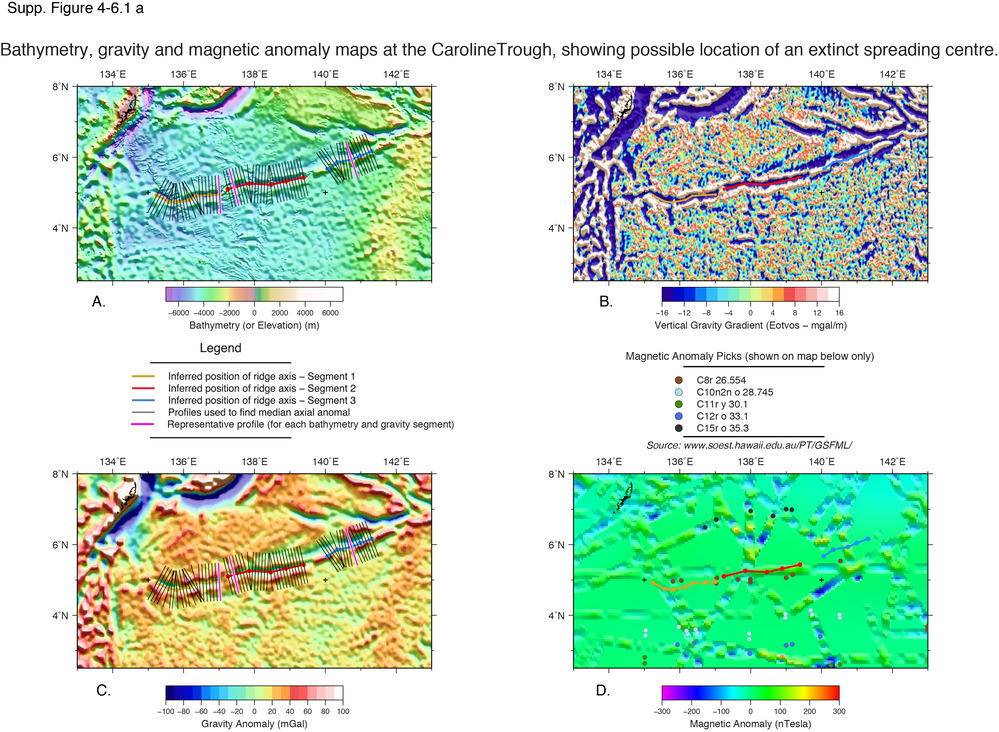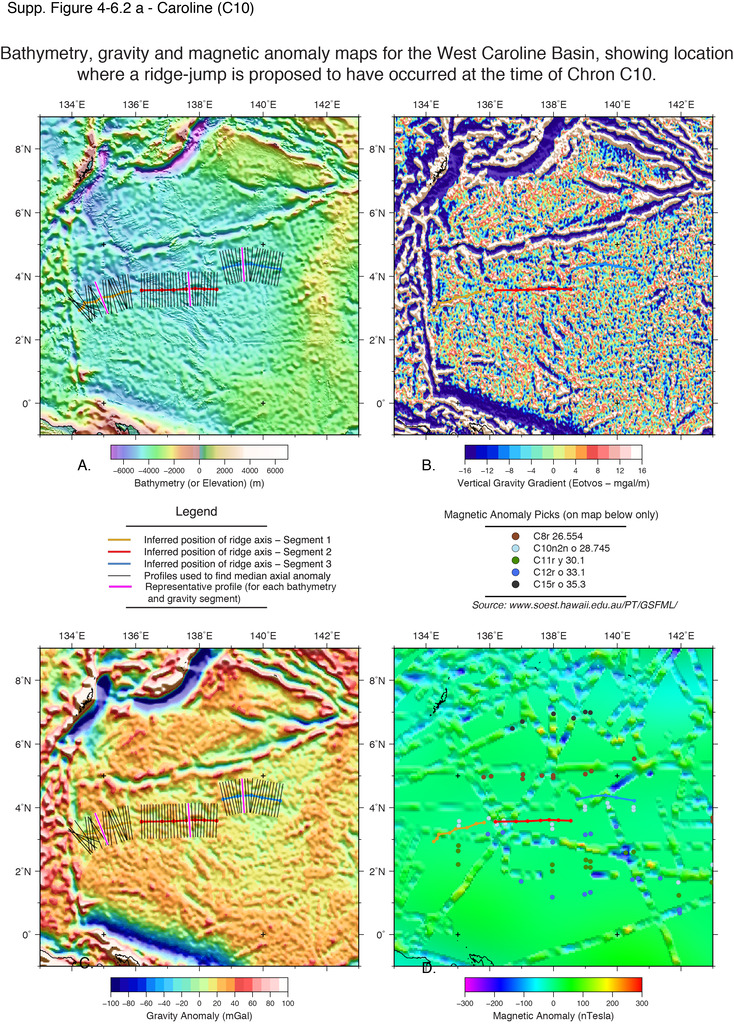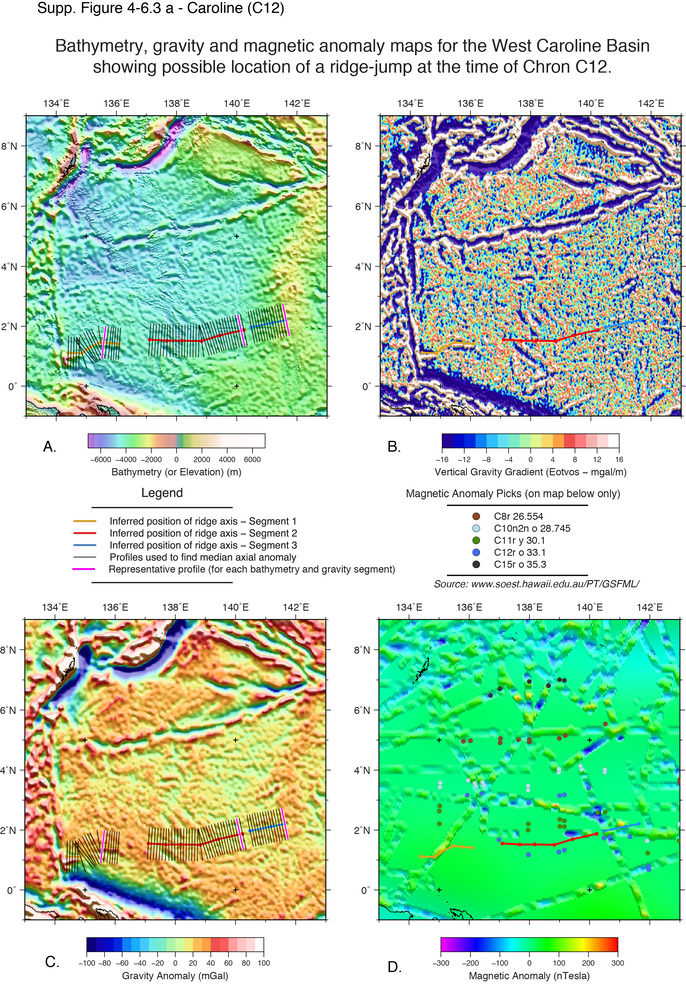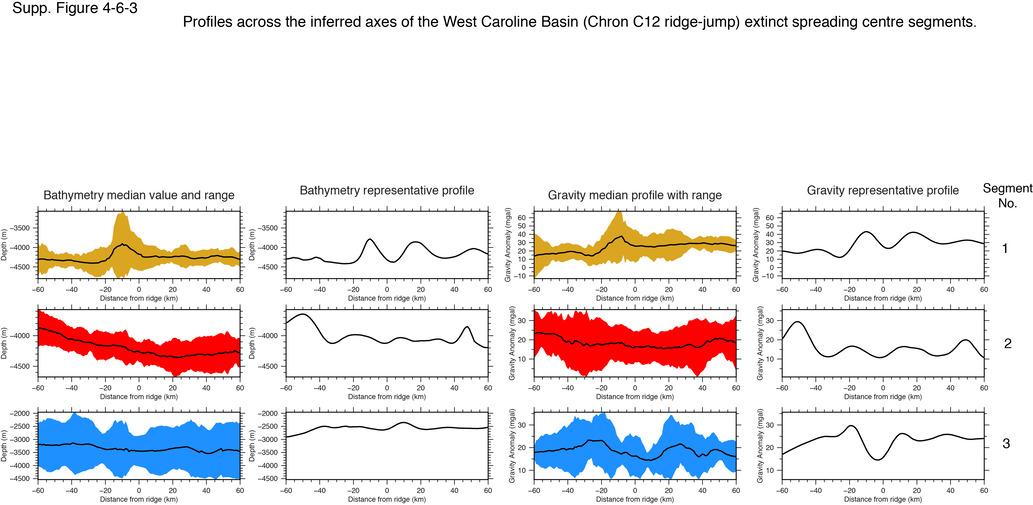| Ocean: | Marginal basin, South East Asia |
| Spreading center type: | Probably a back-arc basin spreading ridge |
| Time of cessation: Caroline Trough | Ca. 26 Ma, chron C8r (Gaina and Muller, 2007) |
| Time of cessation: Caroline proposed ridge-jump (C10) | Ca. 29 Ma, chron C10 (Gaina and Muller, 2007) |
| Time of cessation: Caroline proposed ridge-jump (C11) | Ca. 33 Ma, chron C11 (Gaina and Muller, 2007) |
| Subsequent active spreading center: | None in immediate area |
| Later deformation or volcanism: | Potentially the Caroline Trough was active as a short-term subduction zone, although this is a tentative suggestion proposed here. |
Limited studies have been undertaken to constrain the evolution of the West Caroline Basin (Bracey, 1975), however, from the data available Gaina and Müller (2007) have proposed that three significant ridge-jumps occurred as the basin developed. Gaina and Müller (2007) interpreted the magnetic anomalies either side of the most prominent bathymetric feature in the basin, the Caroline Trough, to be of very different age; namely, chron C8 to the north of the trough and chron C15 to the south. This interpretation suggests that if the structure were formerly an extinct spreading ridge, not all of the crust formed at the center has been preserved. Although asymmetry of crustal accretion across plate boundaries is not uncommon (Müller et al., 2008), we have seen no other extinct ridges from our dataset, or at any active spreading centers, that have such a large asymmetry in identified anomalies. One explanation for the missing anomaly sequence on the southern side of the trough could that a short-lived subduction zone was active in the location of the Caroline Trough, which would have significantly modified the structure of the possible former spreading center.
Gaina and Muller (2007) propose that there were likely to have been two earlier ridge-jumps in the development of the basin, at chron C12 and chron C11. In the region of the inferred ridge jumps, there are no structures suggestive of either pseudo-faults or extinct ridge-like axial complexes in either bathymetry or gravity maps. Additionally, the basin has relatively thick sediment cover which obscures the seafloor tectonic fabric. Updated satellite gravity maps do not provide any additional insight in this case, as there are no prominent linear gravity lows or highs visible.
Gaina and Müller (2007) cite a work by Hill and Hegarty (1988), that proposed that cessation of subduction and backarc basin formation of the Caroline Sea, occurred when the backarc basin exceeded a limiting ridge-trench distance of 1000km. Gaina and Müller (2007) also suggest that the reason for spreading cessation was a convergent collision of the Caroline and Melanesian arcs prior to 25 Ma. The activity of the Manus hotspot near the ridge axis is argued to be the cause for the two earlier proposed northward ridge-jumps (Gaina and Müller, 2007) at chron C10 and chron C11.
The Caroline Trough has a complex structure that varies widely along its length; changing from a pronounced axial trough with an east-west strike in the west, to an axial ridge with an oblique southwest-northeast strike in the east. Magnetic anomalies identified to the north of the trough are thought to represent chron C15 and to the south of the trough, the closest chron is thought to be C8 (Gaina and Muller 2007). This interpretation suggests that some oceanic crust has been consumed and that the Caroline Trough may have been a short-lived subduction zone.
Bracey, D. R. 1975, Reconnaissance geophysical survey of the Caroline Basin, Bulletin of the Geological Society of America, v. 86, no. 50607, p. 775–784.
Hill, K. C., and Hegarty, K. A., 1988, Tectonic interactions between New Guinea and the Caroline plate — Implications for backarc spreading, Achievements in Australian Geosciences — 9th Australian Geological Convention, Brisbane, Geological Society of Australia, p. 192–193.
Gaina, C. and Müller, R. D. 2007, Cenozoic tectonic and depth/age evolution of the Indonesian gateway and associated back-arc basins, Earth-Science Reviews, v. 83, no. 3-4, p. 177–203.
Müller, R. D., Sdrolias, M., Gaina, C. and Roest, W. R., 2008, Age, spreading rates, and spreading asymmetry of the world’s ocean crust, Geochemistry, Geophysics, Geosystems, v. 9, doi: 10.1029/2007GC001743.







